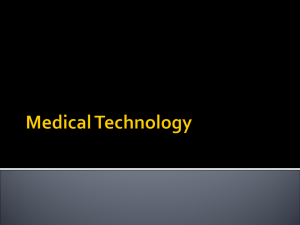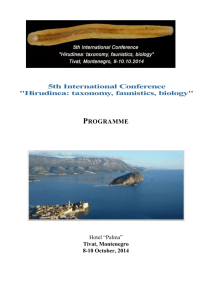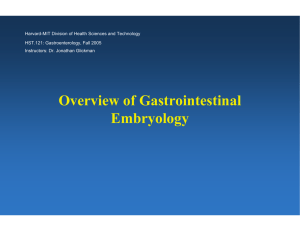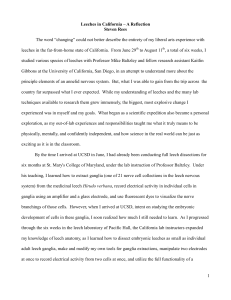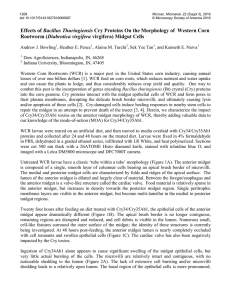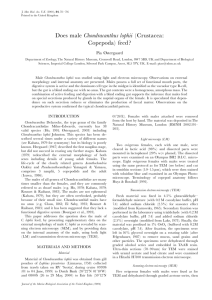Science Investigatory Projects Training Workshop
advertisement
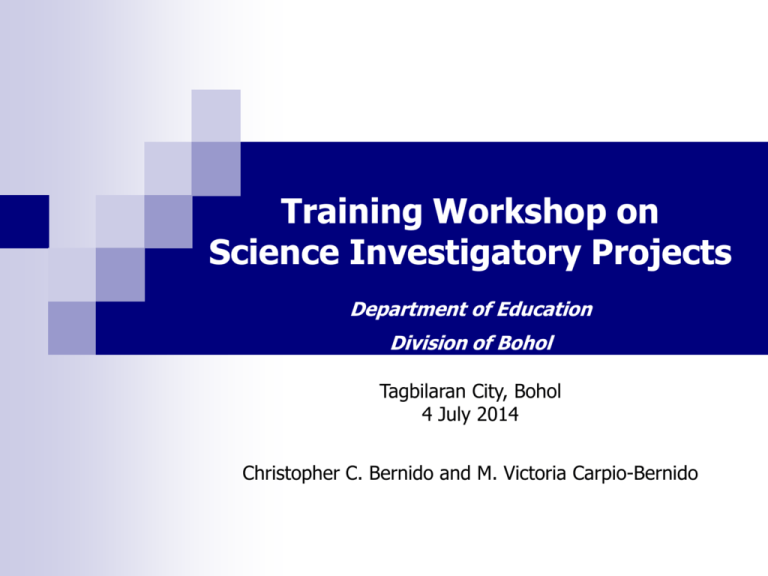
Training Workshop on Science Investigatory Projects Department of Education Division of Bohol Tagbilaran City, Bohol 4 July 2014 Christopher C. Bernido and M. Victoria Carpio-Bernido Stages of Learning* PRIMITIVE LEARNING: Imitation and modeling 2nd STAGE: Solving problems with known answers or solutions 3rd STAGE: Solving problems with unknown solutions 4th STAGE: Identifying and solving core problems HIGH STAGE: Creativity and synthesis M. V. Carpio-Bernido and C. C. Bernido, Notes from Jagna: Bridging Theory and Practice with the CVIF Dynamic Learning Program, (CVIF, Jagna, 2006); M. V. Carpio-Bernido, “Physics, Pedagogy and Cognitive Neuroscience at the Crossroads,” Plenary Lecture at the 24 th National Congress of the Samahang Pisika ng Pilipinas, Ateneo de Davao University, Davao City, 25-27 October 2006. GUIDING PRINCIPLES Learning by doing. For science and math, students need to think with their own minds and work with their own hands. Sound fundamentals. Virtuoso levels are reached only by being well-grounded in the fundamentals. Mastery not vanity. Simple problems completely and clearly solved have greater educational value than advanced problems sloppily analyzed with forced final answers. Adaptability. An educational program must be adaptive because no two learning situations are identical. Honesty. Cheating is unscientific. Fraudulent data invalidate evaluation and assessment. Creative minds Training Discipline Stamina Advances in Science and Technology Better products, services, health “The key to the cultural development of the Western world has been research, the reduction of areas of ignorance by discovering new truths, which in turn lead to better predictions, better ways of doing things, and new and better products.” J. W. Best and J. V. Kahn, Research in Education The fruits of research: • better ways of preventing and treating diseases • improved production and preservation of agricultural products • better consumer products • high technology gadgets and appliances • better ways of understanding the behavior of individuals and groups ... Characteristics of research* Directed toward the solution of a problem “The purpose of research is to discover answers to meaningful questions through the application of scientific procedures.” – M. Jahoda et al., Research Methods in Social Relations Not just information retrieval (from libraries or the Internet), but develops generalizations, principles and theories with predictive power Based on observable experience or empirical evidence Demands accurate observation and description *J. W. Best and J. V. Kahn, Research in Education Involves gathering new data or using existing data for a new purpose. Involves carefully designed procedures that apply rigorous analysis. Requires expertise. Objective and logical, eliminating personal bias. Typically patient and unhurried activity, with attention to detail. Carefully recorded and reported for the scrutiny of, and possible replication by, other scholars (publication in international scientific journals). Motivations of a scientist Curiosity Practicality Orderliness In selecting a topic for research, the scientist must rely on his own preference and not wait for someone to prescribe an area of research for him. The best scientific minds pursue topics which interest them most, and thereby generally get the best results. The Research Process Selection and formulation of the problem Survey of present state of knowledge of the problem Research design and plan to test a hypothesis Observation and experiments Analysis / interpretation / conclusion Publication in an international scientific journal Selection and formulation of the problem Find a problem in need of a solution. Make the problem concrete and specific. Identify the nature of observations and evidence which might help to solve the problem. Formulate hypotheses that can be tested. Formulation of hypotheses Formulate the problem in such a way that will allow conclusions to be drawn about more general aspects. 1. 2. 3. 4. Guide questions: What aspects/components of the object may be transformed/chemically active? By what are the particular aspects or components changed? What are the variables to be measured? What are the relations between the different variables? Data collection Observations Qualitative: verbal descriptions Quantitative: measurements Photos and videos Controlled experiments: designed to test a hypothesis Checks whether there is a causal relationship between a particular factor (independent variable) and a particular predicted phenomenon (dependent variable) Experimental group and a control group Example Testing whether the period of a simple pendulum depends on mass of the bob Dependent variable Period T Independent variable Mass M of the bob Controlled variable Length L of the string Testing whether the period of a simple pendulum depends on length of the string Dependent variable Period T Independent variable Length L of the string Controlled variable Mass M of the bob Analysis and interpretation of data Classification of data: tables, charts, and graphs Statistical analysis of data statistics – using measures of central tendency (mean, median, mode), variation (range, standard deviation), frequency distribution Test of significance Descriptive Example for application of tests of significance Testing whether there are any differences among the average weights gained by animals fed with five kinds of feed, Brands A, B, C, D, and E. (analysis of variance) Example for application of tests of significance Selecting the most effective cleaning agent from three candidates, C1, C2, and C3, for cleaning a metallic surface. The cleanliness of the surface is measured in terms of reflectivity. (analysis of covariance) Ref: J. E. Freund et al., Manual of Experimental Statistics (Prentice-Hall, New Jersey) The Science Fair Objectives of a science fair Develop popular appreciation of the basic and applied sciences, engineering and mathematics. Encourage application of learned concepts and principles. Promote research and development. Provide a venue for interaction among participants and experts. DOST-INTEL Philippine Science Fair INTEL Philippine Science Fair for High School Students Basic Sciences Botany Zoology Microbiology Biochemistry Chemistry Physics Mathematics Applied Sciences Computer and Engineering Computer Science Engineering Medicine and Health Other Applied Sciences Earth and Space Sciences Environmental Science Biotechnology The Science Investigatory Project Applies/demonstrates scientific principles or attempts to provide new knowledge. A result of continuing or parallel scientific research and investigation, and not a copy of any previous research. Has socio-economic significance Contributes to the advancement of science and technology *Based on DOST-INTEL Philippine Science Fair Helpful Tips: Pick your Topic Research Your Topic (Go to the library or internet) Organize (everything learned on the topic) Make a Timetable (Topic is doable in the amount of time you have) Plan Your Experiments (How experiments are done; what is involved) Helpful Tips: Consult Your Advisor (Discuss research plans with adults involved) Conduct Your Experiments (Experimental design; keep detailed notes in a notebook) Examine Your Results (Analyze data; What are the results?) Draw Conclusions (Which variables are important? More experimentation?) ELEMENTS OF A SUCCESSFUL PROJECT Project Data Book: Accurate & detailed notes Abstract: 250-word, one-page abstract which includes the purpose procedure data conclusion ANTI-BACTERIAL AGENT OBTAINED FROM THE MIDGUT OF CATTLE LEECHES Efrellene T. Galula Agusan del Sur National High School Leeches in the Philippines are considered parasitic, useless and source of unpleasant emotions among leech victims and bystanders. This study significantly determines the presence of antibacterial agent from leech midgut as an effective source of natural antibiotics. Large mature cattle leeches were collected from free flowing streams, ditches, canals and those that are attached parasitizing animals. The specimens were soaked in 15% ethanol and then dissected under the binocular dissecting microscope. The fluids in the leech midgut were extracted using heparinized tubes, suctioned and secured in the sterilized bottles. Crude ethanol extraction was done on the midgut fluids then antibacterial assay using S. aureus, B. subtilis, E. aerogenes and P. aeruginosa through Filter Paper Disc Diffusion Method. Zones of inhibition were measured and compared to that of the positive control, chloramphenicol. Data analysis revealed that the crude midgut fluid obtained from cattle leeches significantly inhibited the growth of P. aeruginosa, E. aerogenes, B. subtilis and S. aureus respectively where zones of inhibitions are comparable to antibiotic chloramphenicol. Results concluded that cattle leech midgut fluid possesses antibacterial properties and therefore can be used as an alternative and effective antibacterial agent against diseases and infections caused by both gram-positive and gramnegative bacteria. (This project won 2nd Place, Special Award, American Intellectual Property Law Association) RESEARCH Title PAPER: Includes Page Abstract Acknowledgment Literature survey Methodology Results & Discussion Conclusion Recommendations Poster and exhibit Attractive Well-organized Clear and concise Good material for the display board Correct measurements Characteristics of a good investigatory project for a science fair Originality Planning Creativity Understanding Accuracy Characteristics of a good investigatory project for a science fair Thoroughness of the study Dominant variables distinguished and considered Previous works done properly surveyed Scientific procedures strictly followed Contributes to the solution of practical problems Some Winning Projects (INTEL 2002) “Variations in Leafhopper Populations with Location & Temperature” “Effects of Red-Spectrum Light on Cell Growth” “Biofuel Soaps from Janitor Fish Oil” “Utilization of Mine Tailings as Alternative Raw Material for Earthenware” Some Winning Projects (INTEL 2002) “Histochemical Test and Antibacterial Effect of Oakleaf Fern Extracts” “Anti-bacterial Agent Obtained from the Midgut of Cattle Leeches” “Circle Packing” “Easy create: Web Pages Made Easy” Recommendations Recommendations Learn and follow all the rules. Have a template (preformatted outline and pre-selected font and style) for all research reports and presentation. Check all calculations and statistical analyses for accuracy. Carefully proofread for grammatical and typographical errors. Recommendations Organize a database of all projects entered in the division and regional contests, accessible from a designated website. (To avoid unnecessary repetition, or work on the same topic without improvement.) Classify according to the areas of investigation (e.g., botany, microbiology, chemistry) Study sample winning entries. Science Fair Ideas Science Fair Central Website providing information, tips and ideas on science fair projects: http://school.discovery.com/sciencefaircentral/ Science Fair Project Resource Guide KidSpace at the Internet Public Library provides links to many sites that can help you with science fair ideas. Click on "Choosing a topic" to get a list of links to help you find a science fair idea. http://www.ipl.org/div/kidspace/projectguide/ Agricultural Ideas for Science Fair Projects The USDA has put together some science fair ideas that deal with agriculture. Scroll down the page for ideas in chemistry, botany, environmental sciences, and more. http://www.ars.usda.gov/is/kids/fair/ideasframe.htm IDEAS www.cpet.ufl.edu/sciproj/sci007.htm Physics Stars (binary stars, neutron stars) Planets and satellites Earth weather Physics Lasers, x-rays, microwave Liquid density Water quality Effect on cells, fungi, mold Physics Applications Athletes’ in sports technique Improvement of sports equipment Chemistry Effect of ionic solutions on cells (Ka+, Na+, Ca2+) Effects of chemicals on hair Solubility Detergents Natural sweeteners Biology and medicine Effects of ultrasound Antibacterial agents Herbs and spices Fluids from organisms Behavioral sciences Color and its effect on learning and memory Perception of 3-dimensional objects and illusions Language and learning Environmental science Insect repellents Factors affecting soil erosion Preservation of mangroves Flood control Mitigating typhoon damage of agricultural crops

